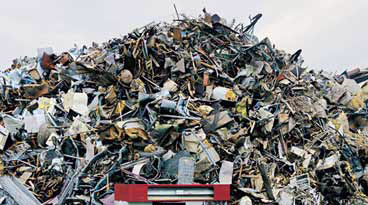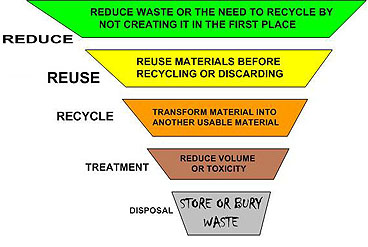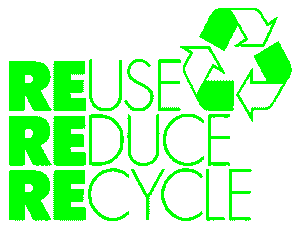Recycling is the reuse of materials / goods that are not used to being another product. In addition to working to reduce the amount of waste that must be disposed of in landfills (landfill). Recycling of useful raw materials to meet the need for a product. And in terms of fuel use recycled can save the energy that must be removed to a factory.
The steps that need to be done to recycle: Separation. Separate the items / materials that can be recycled by the waste should be disposed of to landfill. Make sure the material is vacant and would be better if in a clean state. Storage. Save items / materials that have been separated was dried in a box / closed box depending on the type of goods, such as boxes for waste paper, bottles, etc.. If it will make compost, household waste pile composting on site. Delivery / Sales Items collected are sold to manufacturers who require such waste materials as raw materials sold to scavengers.
The garbage can be divided into 3 types, namely:
I. An Organic Garbage bins are not easily broken / obsolete is not a liquid and gas and is often referred to as dry waste. Inorganic garbage is divided into 2 parts:
a. Obsolete goods. Items that can be recycled back in clean and undamaged condition, has a high economic value. Example: Metal, iron, tin, plastic, rubber, etc..
b. Not an organic waste rotting stuff that really damaged and can not be traded so it has no economic value.
II. Organic waste bins are easily weathered / destroyed, instead of a liquid / gas and is often called the wet garbage. Organic waste consists of 3 parts:
a. Fresh organic waste, such as kitchen scraps, orchards, markets and restaurants.
b. By organic waste such as paper, cardboard, etc..
c. Organic waste recycling options for selected organic waste into compost that is fresh and soft and does not include harsh shaped like a soggy leftover vegetables, spices and remaining fruit.
III. Hazardous Waste garbage that requires special care to neutralize the pollution. This trash should be separated from the others so that the recycling process more quickly and produce products that are free of hazardous materials. Example: broken glass & glass, residual chemicals, batteries, bottles of insect repellent and nails.
COMPOST MAKING FROM OUR SCHOOL
Principles of composting organic waste material containing school + 75%. Composting process of adjusting to the availability of raw materials, which are not collected in large quantities at once, but little by little every day. This condition occurs in nature as the forest floor, where the organic remains fell onto the ground layer by layer until it becomes thick. Overhaul-fermentation process occurs from the bottom soil organisms spread to the pursuit of new materials that fall, followed by the formation of humus from the ground up anyway. Composting speed depends a.1. on the composition of raw materials, the comparison level C (high fibrous material) with N levels (types of legumes, manure, etc..). For optimal compost feedstock ratio C / N = + 30, the final result is humus or mature compost C / N = 12-15 Method and Tool Making compost is actually easy and simple, but because of its location in the yard of the house must be free of odor pollution , flies, dangerous animals and free of distractions chickens, dogs, cats, etc.. Moreover, the organic remains uncollected at once but gradually every day from kitchen waste and yard dirt.
For composting in the school yard, it takes two kinds of containers:1. Large container, container material and the site of the composting process, which is called "Compost" and placed in the garden in the shade.2. Small container in the form of a small plastic bucket with a lid, a temporary shelter kitchen organic waste.
Compost tool is the most practical and safe tool recommended STU Campbell (book "let It Rot", Storey Books, Vermont 1998) for use in the yard. Compost is made from 200 liter drums, the walls removed, and the walls of the base to be able to enter the middle dilobangi 3-4 inch PVC pipe, which also serves drainage. On a 5-cm PVC pipe made hole (drill) along the four sides. Mounted drum stand, given the prop 2-3 layers of bricks. PVC pipe is inserted into the hole basis, until the lower end touching the ground and the upper end of the drum stand up + 10 cm, through the midst of additional cap (can be made from plywood). Small bucket plastic bucket 5 l - 10 l is a lid, reserved for temporary shelter (1-2 days) residual organic orgasisa always placed in the kitchen and the kitchen is closed.
How it Works Composter (drums) placed in the yard in the shade. Should be made of plywood lid over the middle hollow where the advent of PVC pipe. Every time cleaning the yard, in the form of crumbling dirt leaves, grass fence pieces, etc. put into the composter, flattened, slightly compacted and sprinkled on top of a layer of old manure, compost or undercooked new, black fertile soil, and so on. as a starter enhancer N and soil organisms.
If it is too dry to moist and water were shut down to prevent from excessive rain, sun and pollution flies. To facilitate container near the composter supplied starter (cattle dung, etc.) are always closed. Every one or two days, a small bucket of dirt in the kitchen that is full, also included, flattened and coated starter.
So charging is done every time collected organic waste or feces new kitchen, to the composter is full, which takes 1 month - 2 months for a family is. Once full, closed and left behind and forth for 1 month + composting expected to be completed in the form of mature compost black, crumbs and smelling fresh. Composter emptied, its contents aerated, can directly be used alone or filtered (filter wire netting) wrapped and sold.
Occurred since the beginning of the composting process of organic matter incorporated, and propagate upward following the new organic materials. This will prompt a hot fermentation by thermophilic bacteria, as the temperature can rise within enclosed composter, which is also useful to kill seeds and weed pest. Composter is full and I are currently in the process pemasakkan, replaced composter II that had been prepared and later after I finished dokosongkan composter, be prepared to replace the composter II when it is full, and so on.
 Organic materials in the school consists of leaves, paper, leftover side dishes, separated from the rest / non-organic waste. Kitchen waste is put into a small bucket and a non-organic accommodated in another container for disposal in the trash. Every time you include the rest of perishable organic kitchen (the rest of the side dishes), directly on top of a layer of fine sawdust sprinkled meetings. Then in the kitchen is always provided fine sawdust in a special container. Small bucket must always be sealed and usually within 1-2 days is full, then immediately taken to put in a garden composter, and sprinkled a layer on top of the starter.
Organic materials in the school consists of leaves, paper, leftover side dishes, separated from the rest / non-organic waste. Kitchen waste is put into a small bucket and a non-organic accommodated in another container for disposal in the trash. Every time you include the rest of perishable organic kitchen (the rest of the side dishes), directly on top of a layer of fine sawdust sprinkled meetings. Then in the kitchen is always provided fine sawdust in a special container. Small bucket must always be sealed and usually within 1-2 days is full, then immediately taken to put in a garden composter, and sprinkled a layer on top of the starter.So as not to dirty plastic buckets, plastic bags should be coated so that the rest of perishable organic kitchen can fit securely and tightly. If it can be realized every household willing and able to recycle organic waste yard, and kitchen into compost, then dumped household waste is low and does not cause environmental pollution.
Lived waste disposed in the form of non-organic waste such as used goods plastic, tin, iron, etc and a little hard of organic waste such as scrap items of wood, bamboo, cardboard, hard rind and most of these items can be exploited through scavengers. In this way almost all the organic material that can be recycled urban waste problem can be solved in a healthy and supportive safety earth.
One thing, where people have not managed to connect the disconnected recycling cycle, namely the problem of impurities (taeces) and human urine because it is still hampered by cultural issues.



No comments:
Post a Comment